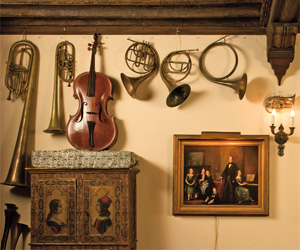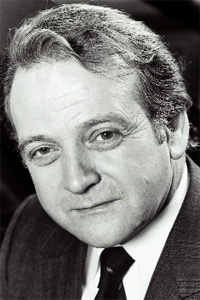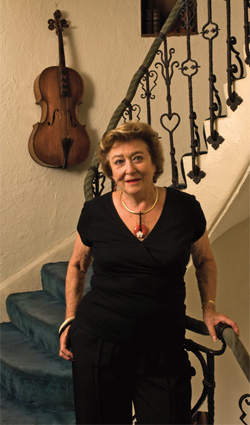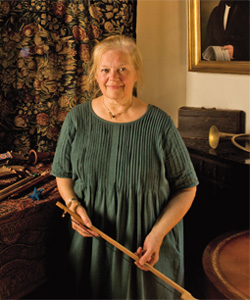Object Lessons: The Selch Collection of American Music History
A seminal collection of American music instruments and artifacts comes to Oberlin

Patricia Bakwin Selch’s townhouse on Manhattan’s East Side is crammed with books, paintings, artifacts, and especially, musical instruments. These objects line the corridors and the winding staircases; they hang on the walls of the music room, the library, and the dining room. One upstairs closet is filled with stacks of framed artworks on paper illustrating musical subjects; another holds a collection of cello-sized 19th-century American Yankee basses. A pedestal side table holds a delicate set of American musical glasses; nearby is a painting of an early 19th-century family gathered stiffly around their piano.
The collection is the product of the lifelong obsession of Patricia Selch’s late husband, Frederick R. Selch, known as Eric. Selch, who died in 2002, was passionately interested in music and its context. The resulting collection contains 6,000 books, manuscripts, printed and manuscript music, and instruction manuals and tutors for playing instruments. There are nearly 700 instruments of all kinds, especially American-made ones, with a concentration in 18th- and 19th-century string instruments. There are also paintings, prints, drawings, tintypes, and paper photographs that depict instruments and music making, and a vast collection of ephemera: music trade cards, playbills, programs and concert announcements, small decorative arts depicting musical subjects, archival records, and correspondence.
”Eric was not just a collector. He was very much a scholar, and he built his collection to be used.”
Although Selch initially collected European instruments, his ultimate focus was on American ones, and his primary interest centered on the music, culture, and history of the Americas. He conducted landmark work on Southwest and Central Native American instruments and culture, and he was engaged in these studies when he died. “He was not content to study music in isolation,” says Barbara Lambert, curator of the Selch Collection. “He was interested in the sources and influences on all types of American music-secular, religious, political, and economic-that shaped its development.”
The instruments in the collection provide a rich resource for the study of organology-the history, design, materials, construction, and use of musical instruments. “The holdings are extraordinarily varied,” says Lambert. “Choose any subject and a small exhibition on that topic can be drawn from it.”
A Center for Study
Patricia Selch has donated her husband’s collection to Oberlin, where it will form the backbone of the Frederick R. Selch Center for American Music at the Oberlin Conservatory of Music. She has also pledged $2.1 million to Oberlin College to create the Frederick R. Selch Professorship of Musicology. In conjunction with the opening of the new Phyllis Litoff Building, the collection and the professorship will help expand Oberlin’s position as a powerful center for the study of American music.
“The gift of such a magnificent and important collection, in conjunction with the generous endowment of the Selch Professorship, will provide an unparalleled platform for the teaching and scholarship of American music that will be envied by all the finest institutions in the country,” says Dean of the Conservatory David H. Stull. “Generations of students, faculty, and visiting scholars will benefit immeasurably from this extraordinarily generous donation from Patricia Selch.”
Professor of Musicology Steven Plank is director of Oberlin’s Division of Musicology. He believes that the acquisition of two important and distinct collections-the Selch Collection and the Jim and Susan Neumann Collection, a major archive of jazz recordings and memorabilia-places Oberlin “on the cusp of gaining an exponential growth in American materials. The notion of creating a center that brings them into synergy with each other is high on our list of priorities.”
Although the parameters of the center are still under discussion, Plank sees it as becoming a force for interdisciplinary study, providing resources and structure for resident faculty and students as well as visiting scholars with an interest in American studies. “Oberlin is an extremely dynamic place, and the presence of one thing will lead to others,” he says. “For example, I imagine that the presence of these materials will inspire performance projects and the like. Someone studying the collection might see an unusual instrument, wonder what its repertory would be, and approach performers to explore this repertory in concerts.”
So Many Books .

Eric Selch
The collection represents an enormous range. While Selch’s primary interest was in American music, he also collected early European books and objects that explored the evolution of music, musical instruments, and music theory; some of the volumes are the rarest of rare books in these fields. Deborah Campana, the Conservatory Librarian, says, “It seems that every treatise I had ever studied while working on my PhD in music theory is in this collection. There are first editions and very early editions. Two of the most famous first editions in the collection are Heinrich Glarean’s Dodecachordon, published in Basel in 1547, and Gioseffo Zarlino’s Le Istitutioni Harmoniche, published in Venice in 1558. Both works focus on the development of the twelve modes-two of the more prominent we know today as the major and minor scales.”
The oldest volumes in the collection are early 16th-century books on musical instruments by Agricola and Luscinius. There is also the early 17th-century Syntagma Musicum of Michael Praetorius, the first scholarly work to be published that encompassed all aspects of musical instruments and performance of the Renaissance and early baroque periods.
The collection also contains many books and publications that illuminate the practice of music in America. There’s The Massachusetts Compiler of Theoretical and Practical Elements of Sacred Vocal Music, published in Boston in 1795, the first American book on harmony, and The Instrumental Assistant, Vol. 1 (Exeter, 1800), the first comprehensive American tutor for musical instruments-the violin, flute, clarinet, bass viol, and “hautboy” (oboe). Indeed, the collection includes dozens of unusual 18th- and 19th-century tutors (playing instruction manuals), covering instruments as varied as the accordion, the banjo, the fife, and the melodeon.
. So Many Instruments
Selch was a bass player himself, so it is not surprising that he acquired 60 Yankee bass viols and similar instruments, including some made by Abraham Prescott, the most famous New England builder.
There are 50 violins, mostly American; together with the basses, they form a core collection for the study of early American bowed string instrument building. Associate Dean Michael Lynn, the Conservatory’s curator of musical instruments, believes that having so many American instruments is unusual: “If you went to a music store in Cleveland in 1860 to buy a violin, you would probably get a European import,” he says. “There were American makers then, but not so many.”
Early American woodwind and brass instruments are represented. Some of them, such as saxhorns or “over the shoulder” horns (with tall bells pointing upward, the better to be heard outdoors or in parades), eventually fell out of use.
“The woodwind collection is especially good,” says Barbara Lambert, who will continue to curate the collection at Oberlin for the next three years. “It includes a small but choice representation of most types of bagpipes-Eric was also a piper -as well as a triple Welsh harp, which is quite special.” The Selches gathered exotic instruments on their many travels, and Selch’s mother added a small but choice group of Afghani instruments while teaching English in Afghanistan in the late 1950s and early 1960s.
“This collection falls between the kind of strict instrument collection, like in the Metropolitan Museum of Art or the Smithsonian Institution, and the kind of collection that you would loan out to students,” says Michael Lynn. “It’s not the value of any particular instrument in the collection that makes it interesting, but the totality of it, the progression that shows how we got to where we are now.” Lambert agrees: “While Eric appreciated the rarest, highly decorative and beautiful instruments, he was really more interested in instruments that had been used-the everyday, serviceable instruments that were the mainstay of musicians.”
A Collector and a Scholar

Patricia Bakwin Selch
As Patricia Selch describes it, “the thrill of the chase was a big part of my husband’s love of collecting.” Eric Selch was born in upstate New York, the son of a Congregational minister who was also a puppeteer who built his own puppets. Selch graduated from Hamilton College in 1952, and the couple married in 1953. In 1955 they moved to England, where Selch produced some of the earliest television commercials for the advertising agency J. Walter Thompson. There he continued scouring the countryside for musical finds. Their most expensive purchase during those early years, a serpent (a bass wind instrument descended from the cornett), cost them $35. As the years went on, they traveled around the world (though with a particular interest in the Northeastern United States), dragging his collection of reference books and their purchases along the way. Selch haunted flea markets and antique shops, and he would take additional objects in order to secure the one he wanted.
He soon began searching for American bass viols, homespun violoncellos (not to be confused with European violas da gamba) that were used to support the bass line and help maintain the pitch of choirs in New England churches lacking organs. He sometimes discovered bass viols in forgotten corners and closets of those churches.
In a book barn in Pennsylvania, Patricia noticed a wooden box that turned out to be filled with an extensive music collection of works and parts for orchestra and for flute and piano. The collection had belonged to Pierce Butler (1806–1867), a wealthy Philadelphian and Georgia plantation slave owner who was, according to Lambert, a competent semi-professional flute player who secured an introduction to his future wife, the great English actress and abolitionist Fanny Kemble (1809–1893), by playing in her theater orchestras. The box also contained her memorabilia. One of the seven major exhibitions that Selch created and presented took place in 1987—a large loan show of books and objects (many from his own swiftly expanding collection) at the Grolier Club, titled “The Magnificent [Fanny] Kemble.”
Selch also discovered the long-abandoned workshop of William Whiteley, of Utica, New York, a fine 19th-century woodwind, violin, and barrel-organ maker-the sort of find that underscores his fascination with the practical side of music making. Michael Lynn remembers hearing about the find when it happened: “The whole shop was there, with instruments that had never been played. Normally collectors get instruments that have been beaten up, played for many years, even altered-but these were fresh from the workshop.”
Selch earned a master’s degree in music history from New York University in the 1960s, but he was also a fervent autodidact, becoming an expert on little-known areas of the study of American music, musical instruments, and their context. In 1971, he met Lambert (who at the time was curator of musical instruments at the Museum of Fine Arts, Boston) when they participated in founding the American Musical Instrument Society. The two sometimes collaborated on each other’s respective research: Lambert’s on early New England secular music, and Selch’s on early New England sacred music. Selch also formed the Federal Music Society, an ensemble of professional and amateur players, and served as its artistic director. Between 1976 and 1983 they performed more than 70 concerts of a variety of early American music, often using instruments and music from his collection.
Selch was well known for his openness and generosity in sharing his collection and knowledge with others, says Lambert. He mounted many exhibitions, both large and small, of books and instruments drawn from his holdings, wrote catalogues and numerous journal articles, published Ovation magazine, and taught a course on the history of musical instruments at NYU.
“Eric was not just a collector,” says Patricia. “He was very much a scholar, and he created his collection to be used.” Late in life, Selch earned a PhD in American Studies from NYU. His doctoral dissertation, “Instrumental Accompaniments for Yankee Hymn Tunes,” documented the use of musical instruments in Protestant New England worship earlier than scholars had realized. Much of the research for his dissertation was drawn from his own library, including his large collection of psalm- and hymn-tune books.
The Selch Collection at Oberlin
Because the availability and dynamism of his collection was essential to Eric, Patricia was intent that a home for it be found at an educational institution, where it would be used and studied rather than lie fallow in a museum. “I am so pleased that his center will be realized at Oberlin,” she says.

Selch Collection curator Barbara Lambert
Logistically, the timing of the gift to Oberlin is ideal, since the Conservatory is expanding its space with the new Phyllis Litoff Building, scheduled to open in fall 2009, which will afford new spaces for housing and using the collection [see Construction Begins on Phyllis Litoff Building]. The Litoff Building will include a climate-controlled vault for the Conservatory’s rare books, which until now have been kept with the rest of Oberlin’s Special Collections in the Oberlin College library, located in Mudd Center. Now, the rare music books-including the Selch Praetorius and others-can be on-site in the Conservatory. There will also be a room to house parts of the Conservatory’s instrument collection, now expanded by the Selch holdings. Some of the oil paintings will be kept at the Allen Art Museum.
The Conservatory also plans to display elements of the collection. Once the Litoff Building is complete and Conservatory space is reallocated, Michael Lynn, who as Associate Dean is responsible for facilities, plans to create a musical instrument study classroom in Bibbins, which might include showcases that are transparent to the hallway. Lynn also hopes to use a parlor room in the Burrell-King house, home to Oberlin’s Community Music School, as a showcase for the collection. “I’d set it up as a 19th-century music room, using materials from the collection, including some of the artwork, to guide us exactly in how to put that room together. The idea of ‘music in the home’ parallels what Oberlin is trying to accomplish with music in the community, vis--vis the Oberlin Community Music School.”
Courses of Study
The musicology faculty has already begun to think about how the collection might be used in coursework. At least one course each year will be built around materials from the collection, and the possibilities are endless. Dean Stull offers as an example a course in organology that would use Selch instruments to show the construction process of a single American builder. Or, he says, “There could be a course on early American folksong-there’s lots of material. The American artworks featuring music could be at the center of an art history course.”
Steven Plank points out that the gift of the collection and the professorship will enable Oberlin to build on the strong programs already in place. “We have a good organology program that was built by Professor of Ethnomusicology Rod Knight. [Professor Roderic Knight retired in May 2008 and donated his personal instrument collection to the Conservatory.-Ed.] With professors such as Wendell Logan and Claudia Macdonald, our curriculum is already rich in studies of American music history. In the last 20 years or so, we have seen a trend of greater democratization in musicology. Our gaze is no longer exclusively fixed on Europe and on the canon. The blossoming of American studies goes well with the notion of being a scholar of your own backyard, a fruitful and widespread activity these days. We’re excited that these new resources and materials will move us even further in that direction. The Selch Collection gives us considerably greater resources, tighter focus to existing endeavors, and opens the door to a lot of new possibilities.”
Just having the primary source material ready to hand, Plank says, will be stimulating for the faculty and the students. “We’ll have the ability to discuss artifacts in classes. Let’s say that I’m teaching a course in 20th-century music, we get to Ives, and there’s a reference to town bands. We start to wonder: ‘What instruments did they play? What were they like?’ The Selch Collection has those instruments for us to examine.” Students in the music history department, who have the opportunity to do advanced research, could also benefit from access to such material. “We encourage them to stretch their wings, to use primary source material, and it will be a terrific boon to them. When a collection like this is on-site, the act of browsing can invite the new idea.”
Michael Lynn, who teaches in the historical performance department, sees possibilities for all kinds of sociological and historical study of music. “When studying 19th-century music, the opportunities of comparing the ‘modern’ instruments of the day to the modern ones of 2008 will be vast and valuable. An average student, even at Oberlin, assumes that if Brahms were conducting, it would be the same sort of orchestra as we have now. The books are also a fantastic part of the collection-included are a number of the treatises that are really prime sources for the study of musical instruments. Many are available in facsimile editions, but being able to take out the original version of a treatise for the class to see has an impact. It takes things out of the 21st century, and launches us back into the 18th.”
Adding to the Faculty
The new professorship, which is projected to begin in the 2011–12 academic year, is also a critical factor in the expansion of American studies at the Conservatory. Plank says, “The position is slated for an Americanist, which is a wonderfully broad description that could include many exciting possibilities. We might have a series of one-year appointments with different subspecialties of American studies in rotation for a while. It’s all on the table.”
Associate Professor of Musicology Charles McGuire ’92 hopes that the new hire will enable Oberlin to increase its already strong offerings in 20th-century music, which is heavily American in orientation. In addition, he says, “There are four of us in the department now, and the addition of a fifth person makes us so much more flexible and able to offer more things to a wider audience. The watchword of the institution is now ‘interdisciplinary,’ and music historians are some of the best people to teach interdisciplinary courses.” McGuire cites Connections: Art, Music and Culture, Past and Present, a course he co-taught last spring with Professor of English and Associate Dean of the College of Arts and Sciences Nicholas Jones. The course drew on live theater, music, and artworks at Oberlin and attracted both College and Conservatory students.
Steven Plank also looks forward to the possibility of meeting other new demands for teaching with the addition of a faculty member. “The tradition of teaching college music courses has been guided by old-fashioned music appreciation classes,” he says. “There are echoes of that in the curriculum, but we are moving toward more topical courses, taught with great substance but not necessarily requiring musical skill, that would be appropriate for college students. At the other range of the spectrum, an unusual thing about Oberlin is our ability to offer Conservatory students advanced courses of the sort that would normally be taught in graduate school. The new professorship will give us another specialist to teach new, advanced topics.”
Americana
Professor of Musicology Claudia Macdonald is attracted by the populist bent of the Selch Collection, which reflects her own scholarly studies about music on the American frontier. “I was particularly taken by the collection of pictures, clippings, advertisements, and popular sheet music that shows the very strong community support for music,” she says. “Having a band was a source of pride, something that brought people together. The collection parallels my research on the importance of community music-making in small towns in the West and Midwest around the turn of the 19th century. Music education was considered very important in instilling good morals; it was believed that participation in music made one a good citizen in a democratic society. The Selch Collection shows that music brought a kind of cosmopolitanism to small towns, connecting them, as telephones and the railroad did, with culture back East. It points to the kinds of activities that people engaged in and shows how pervasive music was in communities a century or so ago.”
At the same time, Macdonald is interested in the larger issues suggested by her research: teaching students “how important music has been historically in American society, both at home and in the community. It’s a long American tradition, and as pre-professionals in training, students have a responsibility not just to have careers, but also to continue the tradition of involving many people in music. When the collection comes here, I hope to use it to encourage students to connect locally with what goes on in the community, adding a populist aspect to a higher artistic aspect. It’s important for them to think, as a professional, ‘How do I relate to people who aren’t musicians, but love music?’ The collection is important in thinking about music historically, making that relationship meaningful in our time.”
Oberlin would seem to be an ideal spot for this very special collection, which will be made as widely available as possible, in keeping with the wishes of the donor. Access will be provided to Oberlin people as well as to visiting scholars, and duplicates will most likely be lent to other institutions. Michael Lynn says, “We want people to know about the collection, to be curious about it.”
“Europeans are beginning to seriously study earlier American music,” adds Lambert. “I foresee scholars from abroad coming to Oberlin to make use of this premier collection.” Might students get together and recreate a 19th-century town band? “The performing editions of Eric’s Federal Music Society programs are all ready to go,” says Lambert.
“One of the great things about Oberlin is that if you put something in front of people, they will get interested in it,” adds Lynn. “I look forward to seeing what Oberlin will do with this collection. I’m sure it will be interesting—and a little different from the way anybody else would do it.”
Heidi Waleson is a New York-based writer and music critic. Her articles have appeared in the Wall Street Journal, Early Music America magazine, Symphony magazine, and Opera News, among others. She wrote about Oberlin’s American premiere of the opera Lost Highway for the 2007 issue of this magazine.
Editor's Note - Effective April 22, 2010: Since this article originally appeared, the Litoff Building has been renamed. Oberlin's new home for jazz studies, music history, and music theory is now the Bertram and Judith Kohl Building.
